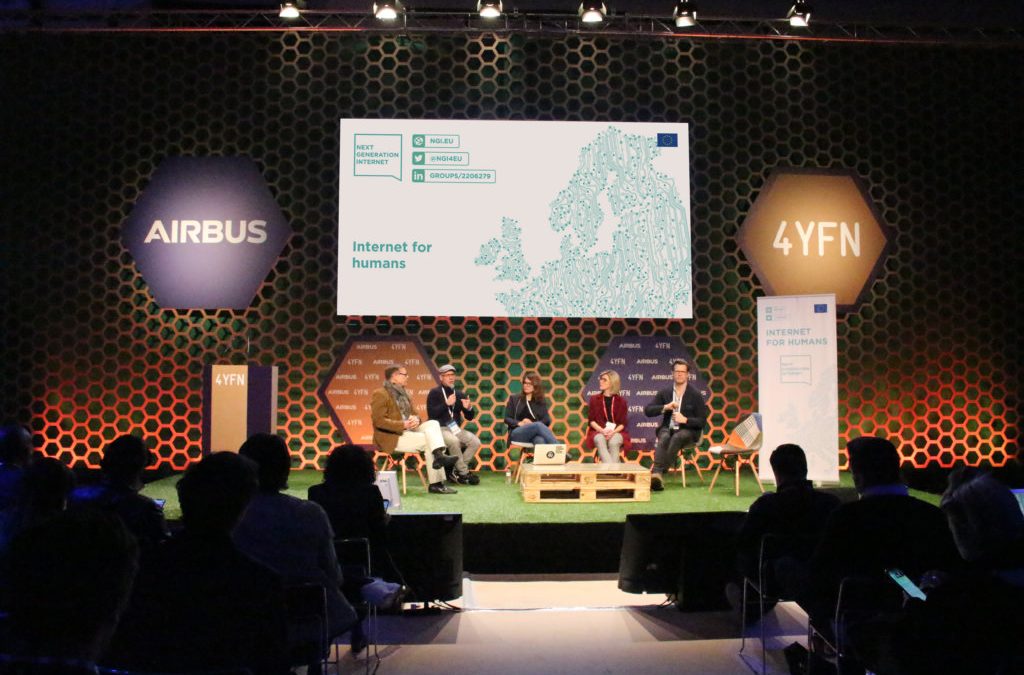Last week a great delegation representing the Next Generation Internet initiative made it through the European blizzard to Barcelona. The occasion was 4YFN, the startup branch of the Mobile World Congress. The vision we are advocating for is that of the Internet as an interoperable platform ecosystem, where players are aware of their societal impact, they pay attention to privacy and data circulation, enable participation and diversity by design. Grounding a vision is always challenging and 4YFN provided some food for thought. Here are a few recommendations for the next steps:
Value startups with a mission: there will always be newly born companies getting excited at the idea of selling ads to people with a complex mix of blockchain, Ponzi schemes and gamification. But at the same time, we can see a European trend to provide true value to clients and to be inspired by strong values. I have met young CEOs speaking with a twinkle in their eye about reducing CO2 and cut the wewashing market; making reading an affordable experience for visually impaired people; enhancing privacy in conversations. This kind of entrepreneurship must be rewarded and highlighted. The NGI Awards aim to do so, promoting European Internet excellence in entrepreneurship, research/education and culture.
If you represent the big picture, don’t be afraid to zoom out: we are socially conditioned beings; so no surprises everybody jumps on the bandwagon, currently with the number plate “blockchain”. There are high chances that the after the buzz, blockchain is going to end up before the court of History as the worst tech thing that ever happen to humanity. But before that, it will make it to many markets. Conversations around whether blockchain is pertinent in any given context, or about its impact on the environment and on social ties like trust, must be run in order to complete those around how to get rich with cryptocurrencies.
Make it a meaningful conversation: people liked the idea of an “internet for humans”, many stopped by the booth attracted by this highly visible slogan. They wanted to know why, how, and they had their own opinion about what it means (mostly: get out of the technocentric conversation, give us back some dignity as human beings and not just as gears of the data machine). By popular demand, the shield for covering the webcam was the most-wanted gadget (if you don’t know why you should protect your camera, here’s a reason and here another). Aiming for a Next Generation Internet means that we need to create protected space for conversations that are relevant to citizens’ wellbeing and sense of purpose. Enough with the entrepreneurial macho style and the cult of efficiency at any cost.
Cherish EU startups with dedicated and effective communication: most of them don’t know they can be involved and if so, they believe the system is way too complicated to make it a sustainable option. One can’t say that the bureaucracy and timing hurdles of EU funding are a facilitator for innovation and agility. At the same time, efforts have been made in recent years to value impact, develop cascade funding systems (the coming Next Generation Internet call will see 80%* of the budget invested in individual organisations for short R&D cycles) and launch an instrument especially dedicated to SMEs. Bridging this information gap is vital to go beyond the usual suspects.
The startup crowd wants to be included in the European conversation but is puzzled about how to do so. It is aware of the challenges related to information technologies and (in most cases) is trying to do something for positive change. It is a league of hard-working people who are shaping tomorrow’s Europe but who doesn’t necessarily have time to dig into Brussels jargon. It is subject to trends in order to get investors (although maybe exactly one of this trends, the ICOs backed by blockchain, will make investors demodé). The times are exciting, and they request making investment policies accessible and long-sighted.
*This information is not fully accurate. More precisely, the ICT-24 call funds RIAs covering three sub-topics, and each will invest 80% of its budget for third-parties. To digest and navigate the correct formulation, a potential beneficiary of the cascade funding must know that every call covering information and communication technologies has as identifier “ICT-a number”; what is a RIA (and how it differs from other actions in the means, funding, scope); what is the difference between being a RIA partner and a third-party; how long it will take approximately from the call deadline to the launch of the RIAs and to the calls for third-parties. It’s not rocket science, but it is just an example of how Brussels love for acronyms does not serve newcomers.
